Last Updated on March 13, 2024 by Aftab Tariq
Full grown bearded dragon is a reptile that can grow about 18 to 24 inches long from its nose to the end of its tail. But how big it gets can depend on its genes, whether it’s a boy or a girl, what it eats, and how healthy it is.
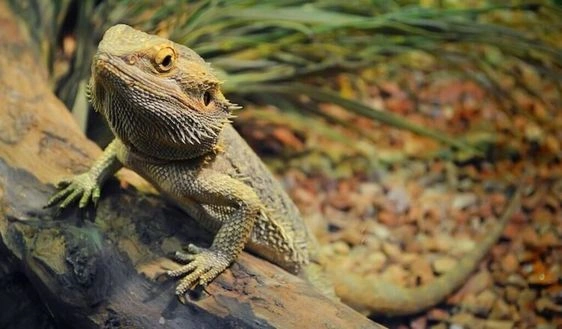
Male bearded dragons are usually bigger than females, but boys and girls can grow to about the same size. It is important to give them enough room to move around comfortably when they’re adults. Adam Beck says,
“In the graceful gait of a full-grown bearded dragon lies the wisdom of ages, a silent sentinel of ancient lands.”
Bearded dragons have tough, spiky scales all over their bodies, like a little suit of armor. They also have spikes under their chin that puff up, called a “beard,” when they feel a certain way. Full grown bearded dragons are a popular choice for pets. The most common type is called the central bearded dragon.
Even though we’ll mostly talk about the central bearded dragon, we’ll also mention how big other types can grow. Basic things like how they act, what they eat, and where they live are the same for all types.
Bearded dragons became popular as pets because they were gentle, friendly, curious, and active during the day. They’re easy to be friends with and fun to watch. In this article we will discuss about Full grown bearded dragon.
Full Grown Bearded Dragon Overview
| Attribute | Description |
| Scientific name | Pogona vitticeps |
| Common names | Beardies, inland bearded dragon, central bearded dragon, bearded dragon |
| Class | Reptile |
| Type | Cold blooded |
| Habitat | Warm and arid climatic zones |
| Temperament | Docile, gentle |
| Life span | 6 to 10 years |
| Size | Up to 24 inches long |
| Diet | Omnivorous: Greens, vegetables, insects, fruits |
| Housing | Juvenile: 40 gallon tank per dragon
Adult: 100 gallon tank/enclosure per dragon |
| Weight | 400 to 500 grams |
People who like reptiles often wonder, “How big is a full grown bearded dragon?” The answer depends on the type of bearded dragon you choose. If you pick the common Pogona vitticeps, it can grow to be 16 to 24 inches long. Here are the sizes of other types:
- Pogona barbata: 24 Inches
- Pogona Henry Lawson: 12 Inches
- Pogona microlepidota: 6 Inches
- Pogona minor minima: 12 Inches
- Pogona minor minor: 18 Inches
- Pogona minor Mitchell: 18 Inches
- Pogona nullarbor: 14 Inches
But it’s not just about size. Consider what helps a bearded dragon grow well and stay healthy.
Factors Affecting Bearded Dragon Growth
Here Are Some Things That Can Slow Down or Speed Up a Bearded Dragon’s Development:
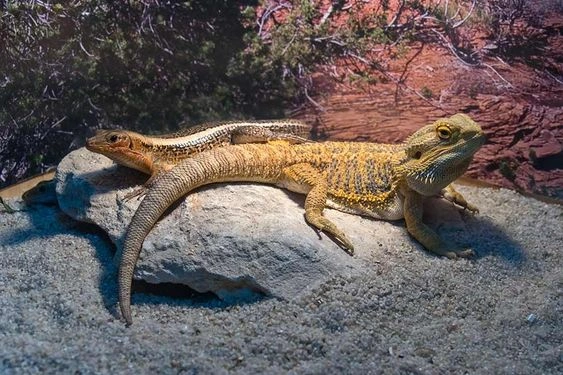
Gender: Beardies are typical of species whose males tend to be larger than females in size variation. If you’re keeping beardies of the same species, you should expect the male to be noticeably bigger than the female.
Varieties And Breeds: As stated earlier (in the species wise size section), variations in phenotypic expressions, such as size, are examples of how distinct kinds have evolved.
Healthy Eating: Nutrition is key when developing into a fully formed adult. A beardie that isn’t getting enough balanced nutrients will stay significantly smaller than usual, while one that is will grow to its full potential.
Environment: Factors about the environment, such as care and maintenance: as animals adapt to their surroundings, your bearded dragon will only reach its maximum size if you subject it to unsuitable or harsh conditions or provide sufficient space. On the other hand, dragons flourish when grown in an ideal setting.
Knowing how tall your beardie will get is one of many things people want to know. Therefore, we also get a lot of requests for a hairy dragon growth chart. You can keep better tabs on your bearded dragon’s health if you know what the average size and weight should be at different points in its development.
By keeping tabs on your beardie’s growth and knowing what size they should be at a specific age, you can detect if they’re underweight or overweight and make the necessary adjustments to their nutrition and care.
Using the bearded dragon growth chart, you can quickly catch any mistakes in your reptile’s upbringing and fix them.
Bearded dragon size chart by age
Let’s look in and learn more about bearded dragons now that you completely understand how far they can grow and the full size chart for bearded dragons. This will ensure you avoid challenges while caring for your lovely dragons.
| Age (in months) | Weight (in grams) | Length (in inches) |
| 0 to 1 | 3 to 5 | 2 to 3 |
| 1 | 4 to 6 | 3 to 4 |
| 2 | 8 to 40 | 5 to 9 |
| 3 | 20 to 60 | 9 to 11 |
| 4 | 40 to 80 | 10 to 12 |
| 5 | 80 to 120 | 12 to 16 |
| 6 | 130 to 180 | 15 to 18 |
| 7 | 230 to 280 | 15 to 20 |
| 8 | 250 to 330 | 16 to 22 |
| 9 | 280 to 360 | 17 to 23 |
| 10 to 12 | 350 to 450 | 17 to 24 |
| 12+ | 400 to 500 | 17 to 24 |
Origin And Habitat of Grown Bearded Dragon
Full grown bearded dragons come from Inland Australia. They live in warm, dry places like scrublands, savannas, deserts, and subtropical woodlands. They’re not big animals, but they’re not tiny either.
These lizards are cold blooded, so they can’t control their body temperature like we can. They need warmth from outside sources to stay cozy. That’s why it’s super important for them to live somewhere warm.
In their hot, natural homes, they love soaking up the sun to warm up. They dig underground or in tree branches to cool off or hide from danger. They’re like half land animals and half tree climbers.
What do adult bearded dragons look like?
Full grown bearded dragons are medium sized lizards that come in different colors, but you usually see them in light to dark brown shades. They have this cool collar around their neck that looks like a spiky beard, which puffs up when they feel a certain way.
Their tails are thick, spiky, and long. Even though they might look a bit scary and are called “dragons,” they’re friendly. That’s why they make great pets.
Full Grown Bearded Dragon Size
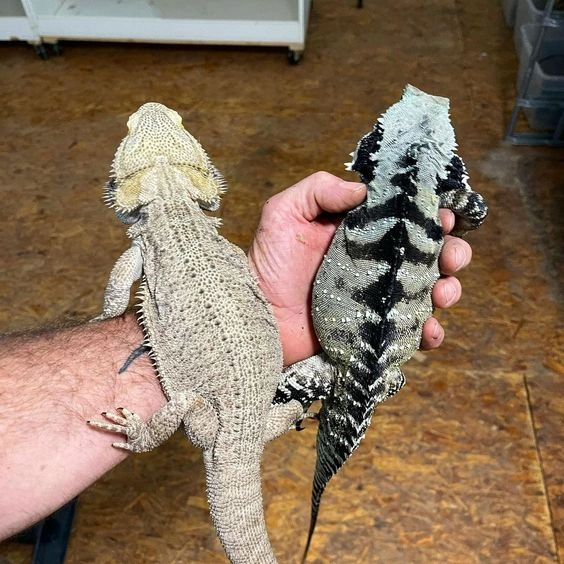
Adult bearded dragons, scientifically known as Pogona vitticeps, can display diverse sizes influenced by genetics, diet, and habitat. Typically, a full grown bearded dragon length is 18 to 24 inches, tail included.
A full grown bearded dragon weight about 400 grams (roughly 14 ounces). Males usually boast slightly larger dimensions compared to females. Providing an appropriate environment, a balanced diet, and attentive care are crucial for their development and overall well being.
Temperament Of A Bearded Dragon
Bearded dragons are active during the day. It’s important to keep males separate because they can get territorial. They might fight over their space, food, or even mates. Sometimes, males can be aggressive towards females if they try to take charge.
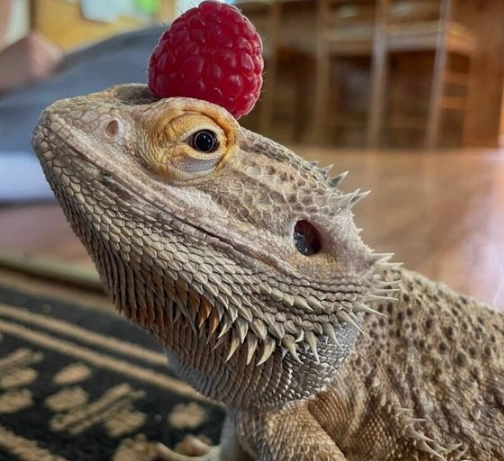
When they feel scared or threatened, their beard spikes stand up, making them look bigger and scarier. They might hiss, too. They can change the color of their beard to talk to other lizards and bob their heads. A slow bob means they’re being polite, while a fast one means they’re showing off.
Overall, bearded dragons are pretty chill and rarely get aggressive. They’re cool with being handled, and some even like hanging out on their owner’s lap or shoulder. They’re curious creatures, which makes them fun to watch.
In colder weather, they might not eat much and even go into sleep mode, where they only drink water occasionally. It’s like they’re hibernating.
Diet For Full Grown Bearded Dragon
Feeding a full grown bearded dragon is easy because they’re not fussy eaters. They eat plants and small creatures, so you have many options.
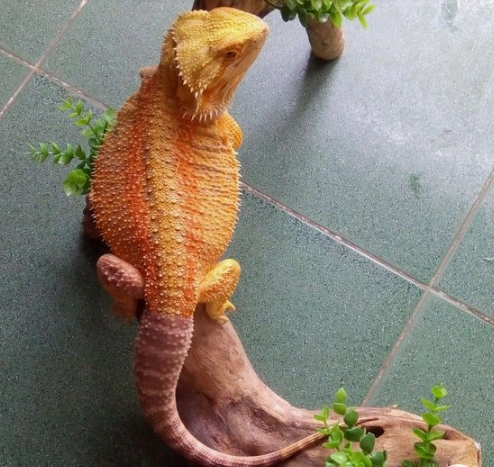
They munch on leaves, flowers, veggies, and sometimes insects and even small rodents. They have strong jaws and can crunch on hard shelled bugs like beetles.
They also enjoy snacking on fruits, but bananas should be given sparingly. They’re high in fiber, which helps digestion, but they shouldn’t be the main part of their diet. It’s better to give them more nutritious foods like proteins and greens.
When they’re babies, they need lots of protein to grow. They start tiny, just a few inches long, and weigh only a few grams. In their first two months, they can gain a lot of weight, so they need plenty of protein from insects.
As they grow into juveniles, from 2 to 5 months old, they still need lots of protein to keep growing. You can also give them vitamin D and calcium supplements to keep them healthy.
Housing For Full Grown Bearded Dragon
Housing for a bearded dragon that has reached full maturity
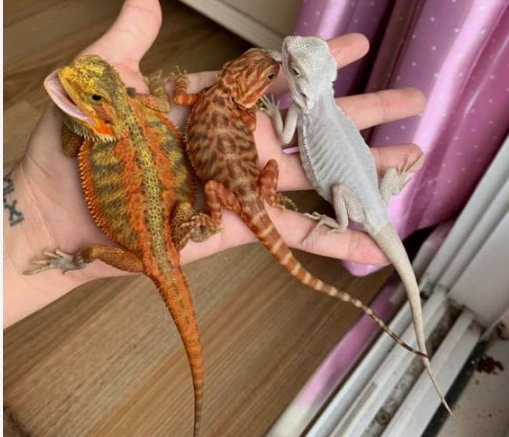
1: Size Of Full Grown Bearded Dragon Enclosure
A bearded dragon pupa can be kept in a tank with a size of forty gallons, while a full grown bearded dragon tank size must be 75 to 100 gallons. They must have a cover on top of their tank to prevent escape.
2: Strengthening
Since they are semi arboreal and enjoy climbing, you can add rocks, logs, and branches to their enclosure. When you want them to have space and feel comfortable, you should always offer them a basking place with higher temperatures and hiding spots such as boxes or hollow logs.
3: Temperature
The temperature is one of the essential elements that must be constantly monitored and maintained in their tank. The temperatures can range anywhere from 65 to 85 degrees Fahrenheit, and they can be found on the side of the tank that is cooler or during the nighttime hours. Heat should be kept at a temperature of between 95 and 110 degrees Fahrenheit in the area designated for basking.
Mercury vapor bulbs, ceramic heaters, ultraviolet B (UVB) lights, under tank heaters, and other similar devices can be utilized to achieve various temperatures and levels of heat. It is possible to monitor the tank’s temperature by using a thermometer placed inside of it.
4: Light
Keep your beardie in a day night cycle that lasts for a total of twelve hours each. Ensure UVB light is sent straight through the screen top rather than via the glass. Exposure to sunshine is a natural and healthy method of delivering light; however, you need to take precautions to avoid scorching them by placing them in a tank outside when you expose them to sunlight.
5: Substrate
A few different types of substrate or litter material can be used at the base of the enclosure. Some examples include paper towels, sand, and reptile carpets. Children and adolescents should avoid sand since they tend to swallow it, which can result in impaction.
For adults, sand can be used since it enables them to dig, which they enjoy. Additionally, if you utilize sand, it is much simpler to scrape out their waste. Shells of nuts, corn cobs, and bits of wood should not be used since they provide a risk of choking if they are used.
6: Humidity
They must keep the humidity in their tank between full grown bearded dragon on leash The tank of theirs can be misted to reach these levels. Maintaining this may be challenging if you reside in a location that experiences a high level of humidity. A hydrometer should be utilized to monitor this parameter.
Full Grown Bearded Dragon On Leash
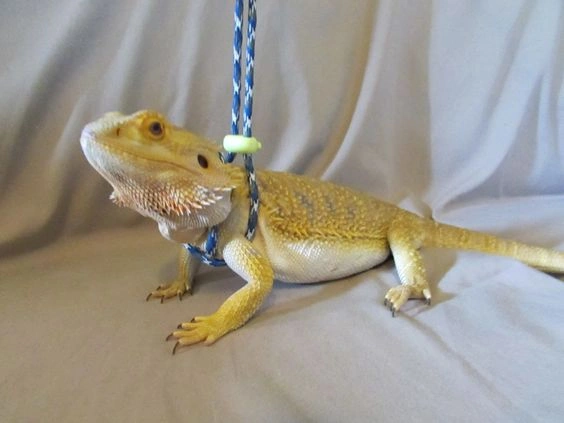
Training a full grown bearded dragon to walk on a leash requires commitment and patience. Even with proper training, some bearded dragons might feel uncomfortable with it.
Bearded dragons are generally easier to train for leash walks compared to other lizards because they’re usually less aggressive. Whether or not your bearded dragon can be leash trained depends on its unique personality, just like with any other pet.
How Long Do Bearded Dragons Live As Pets?
Bearded dragons typically live 10 to 15 years in the wild. But when kept as pets, they can live even longer – up to 20 years! This is because they get regular care from veterinarians and are safe from predators.
It’s important to know that bearded dragons are long term pets. If someone in the family, like a teenager, wants a bearded dragon but then goes away to college, another family member, like a parent or younger sibling, should be ready to take care of the dragon while they’re gone.
Conclusion
Providing your dragon with the appropriate environment, a healthy diet, and proper management will assist them in reaching their maximum potential in terms of growth and health parameters; therefore, you must always stay caught up in these areas.
FAQs
What Is Bearded Dragon Size Cm?
Bearded dragon size cm is about 40 to 61 cm.
How Long Until My Bearded Dragon Is Fully Grown?
Dragons typically cease their growth between 12 and 18 months of age, although a few may continue growing until they reach 24 months.
Source
I am a dedicated content writer with more than five years of experience, particularly skilled in the art of storytelling. My writing journey commenced during my college years, where I pursued journalism and unearthed my talent for creating captivating narratives.


